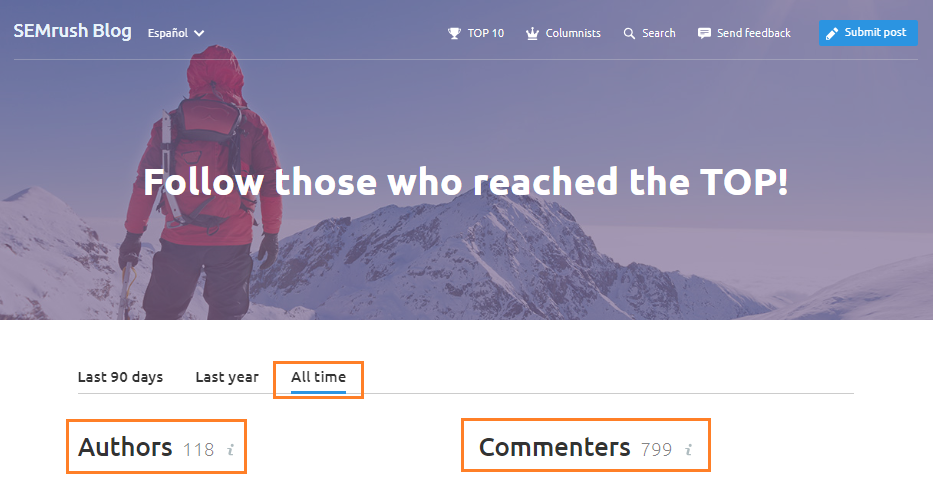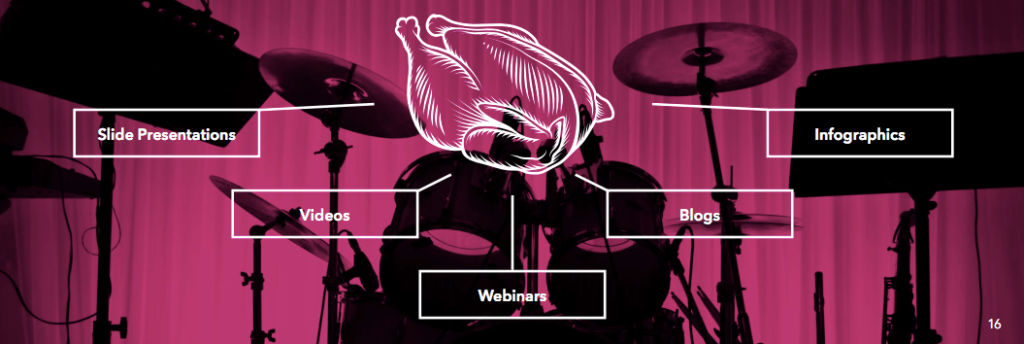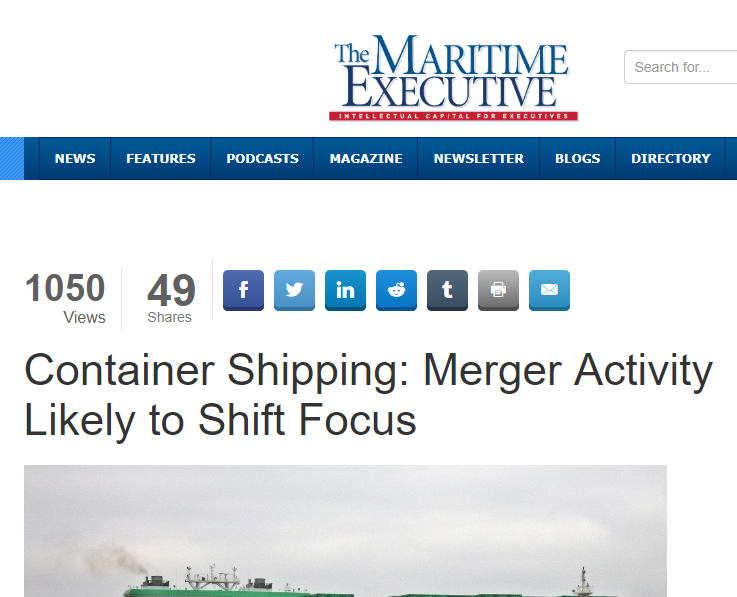It was barely a month into my first job as a content marketer. I was seated right opposite my manager. His gaze was on his computer screen, reading through a draft blog post I’d been working on.
I held my breath, shot a few nervous glances at him and puckered up the courage to ask out loud:
—How am I doing? Am I doing a good job? Is there anything I can do to improve?
I meant to ask about my performance thus far. But since he was evaluating my post, I thought it was a good opportunity to kill two birds.
— You’re doing great. But it’d be better if you could clone yourself.
Though affordable cloning was and still remains a distant possibility, the man had a point. Until 3D printing —or any other technology for that matter— manages to successfully clone content marketers, the best way to produce more with less is through a scalable content strategy.
More content, more impact, more results.
Fewer resources, less effort, less time.
From methodology and workflows to tactics and hacks, there are many ways to scale your content strategy.
My co-founder, Julia, and I met at something very similar to a bootcamp —one in which you learn to do a lot with very little— a startup. It was a pretty intense and fast-paced journey, but also extremely fulfilling. Today, with our own content marketing agency set up, we’re realising how crucial this experience was in helping us scale our efforts as much as possible.
In this post, we’ll share with you our favourite tactics that have helped us make the most of what we have to scale our content strategy.
1. Strike a good balance between evergreen and time-sensitive content
On the one hand, we have evergreen content. Eternally fresh, always relevant, and never failing to feed our Google Analytics reports with more traffic and leads year after year.
On the other hand, we have time-sensitive content. Tagged to certain dates and/or news, they’re pertinent only for a temporary period of time, which can range from days to months. But in this time, they’re extremely relevant and not jumping at the chance to produce this time-sensitive albeit short-lived content if your strategy allowed you to would be a wasted opportunity.
But while both are equally attractive and great content types, they’re not equally as sustainable. Unlike time-sensitive content, evergreen content is naturally scalable.
- You can give it a new spin and re-promote it. Update the piece as and when there are new developments, or make it a point to do so once a year. Create new images and relaunch them on social media or in an email campaign.
- It continues to generate traffic years after publishing it.
This balance between evergreen and time-sensitive content depends on your content marketing goals, your sector, and the needs of your audience.
There’s no magic ratio. But it has to be balanced and it has to fit within your content strategy.
The balance of evergreen and time-sensitive content depends on your #contentmarketing goals, your sector, and the needs of your audience.Click To TweetIn fact, SEMrush Spain produces only evergreen content.
From what they tell us, their strategy relies heavily on over a hundred quality content writers and a high rate of publications. So a 100% evergreen content strategy is needed for survival as keeping all the articles of all these writers up-to-date would be unfeasible.

Alicia Rodríguez Ruiz, content strategist in SEMrush Spain and LATAM, also tells us that it is important to consider the sector and audience when deciding on the types of content to include in a blog.
“Take for example the US, whose content marketing sector is one of the most advanced and developed in the world. It’s important to first check if the sector is receptive to time-sensitive content and then decide who your content is directed at.
It’s clear that there are certain sectors that, given their nature, focus more on producing time-sensitive content. A prime example would be the fashion e-commerce industry, where content is naturally driven by seasons and trends.
In this case, their consumers are very receptive and even have high demands and expectations for content that reflect the ever-evolving trends, fleeting and short-lived as they may be.”
—Alicia Rodríguez Ruiz
2. Repurpose the content as many times as you can
Evergreen content is one of the easiest kinds of content to repurpose into other formats or angles.
A blog post can spark a series of article ideas or a presentation, just as a checklist can be spurned into an infographic. While certain types of content are more easily repurposed into certain other formats, the possibilities are endless.
When a piece of content works, take it as a good sign and do not lose the opportunity to use it as a base and reference to branch out and create others. There’s an extremely high chance of the resulting content to be extremely effective in generating interest.
Plus, you can also
- Considerably reduce production time as there’s no need to brainstorm a new idea. Build on the existing idea and information. All you have to do is develop a new format.
- Increase the possibility of reaching new audiences via new channels with new content, such as YouTube, Slideshare, Medium, etc.
- Get a second chance to reach audiences you weren’t able to reach the first time, either because they missed it or simply because the original format wasn’t attractive enough to get their attention.
3. Invest in producing a piece of epic content
By epic content, we mean a well-researched and well-developed long-format content such as a guide, an e-book or a report from an investigation, study, survey, or analysis of internal data.
This is what Jason Miller, previously the Head of Content at LinkedIn, refers to as “Rock Content”:
“The big rock is a substantial piece of content that you’re creating with the purpose to own a conversation…” “…“ a major stake-in-the-ground strategic piece of content that answers the biggest questions our customers and prospects have.”
Jason Miller
Having such a massive vision may seem contradictory, especially when you’re just starting out and what you really need is to build up your resources. But it is rock content that will give you the productivity you need, all the more when you have limited resources to work with.
In our previous post on the importance of angle in 10x content, we spoke about how important it was to respond to your audience’s needs not only through quality and informative content but also original content.
Rock content fulfils exactly that. It is not only high-quality content that’s informative and educational. It’s, more importantly, based on exclusive data and information that makes the content practically impossible to replicate.
Instead of contributing to content shock, the “big rock” strategy seeks to produce less, but impact more. The cost of content creation is high, but it’s extremely scalable. A rock content is the seed to your beanstalk and can help generate enough content ideas to cover your content strategy for months.
Or as Jason himself puts it, ‘turkey slices that you will share in a variety of ways for the months ahead’.

Depending on whether your main goal is to increase traffic or generate leads, the main piece of content, or “Big Rock”, can be published online or downloaded as a lead generation content.
From there, you can source out content ideas for your:
- Content strategy: Presentations, blog posts, infographics, webinars, quizzes, videos, white papers, etc.
- Media relations strategy: A press release on the findings of your study or survey, which you can further segregate and focus according to geographical zones, professional capacities, etc. You can also craft an exclusive or editorial for a specific media or even get your company’s C-level executives featured in interviews.
- Social media strategy: Craft multiple social media posts with statistics and data obtained from the study and design images and graphs to accompany your social media messages for better visualisation. You may also share any concluding or impactful findings as quotes within images.
4. Integrate your blog strategy with your digital media relations strategy
“Less is more” is also our motto when it comes to producing content for the media.
This revolves making use of an idea that can be developed into a blog post and at the same time spun into a press release or exclusive for the media. The underlying topic and information are largely the same. What’s different is the angle and writing style.
Here’s an example of iContainers, an online freight forwarder, managed this.

In this case, the topic was a market forecast for the year containing expert analysis and quotes. It was put together exclusively from interviews conducted with industry influencers and company experts, which means it not only makes for an informative blog post, but is also relevant for media outlets covering the economy and logistics sectors.
By changing the writing style to take on a more factual and objective tone and the angle to make it more relevant to the economy and market news, they had their story picked up and covered by some of the industry’s largest media outlets.

Each media has its own style, focus, and editorial line, and when pitching your articles to them, make sure to keep them in mind. Adapt your tone and angle accordingly while maintaining the right sense of judgement and tone.
News is time-sensitive
When developing your blog and digital media relations strategy, don’t forget to consider timing. Each industry has its own market cycle and it’s easy to pinpoint topics that have the potential for great impact during certain times of the year.
For example, if you’re in the tourism industry, you’ll want to time your press releases and articles according to the seasons. Eg. talk about tourism forecasts just before the summer season when everyone’s jetting off and not in the depths of winter.
If you’re in the education industry, the start of the school terms in September or January is a good period to aim for.
You get the drift. Plan your editorial calendar in advance and with a calendar in hand to create synergies between your blog and media relations strategy.
At Dear Content, we prefer working on one single calendar that encompasses blog and media strategy so that we can easily pick out news-worthy topics immediately.
If all goes well, by integrating your blog and media strategy, you can:
- Attract organic traffic to your blog
- Expand your reach and gain referral traffic
- Increase brand awareness
- Improve your organic positioning via brand mentions and links to your homepage or strategic pages
5. Recycle, recycle, recycle
A few months ago, I needed to wrap and mail a gift but had neither wrapping paper nor foam bits.
Thankfully, my mother is a bit of a hoarder. She managed to dig up three beautiful wrapping papers for me to choose from and a bagful of foam peanuts. To top it off, she even had one of those colourful scotch tapes that matched the wrapping paper.
These are items —random items— that she stored and saved over the years because it’s in her nature to reuse and recycle where possible.
Content marketers, in my opinion, should take a page out of my mother’s book.
As you build your content, you come across many times where you decide to go with one example or quote over another or delete entire sentences, or even paragraphs. There are certain ideas that are bound to come up randomly but may get discarded.
Don’t be quick to throw these into the shredding machine. Since you’ve already done the work to inspire or obtain them, why not store them? Save them in a separate document —an idea bank, if you will— and you’ll be sure to find the need for them later.
Deleted sentences and paragraphs and unused comments can easily make for supporting arguments for a future post or even inspire a whole new article altogether.
The Memoir Project: A Thoroughly Non-Standardized Text for Writing & Life is a guide that talks about how to write stories that connect with your audience. It also addresses how to revive and reuse fragments of content that was discarded during editing.
As you edit your content, save any deleted sentences, paragraphs, or unused comments. They can make for supporting arguments for a future post or even inspire a whole new article altogether.Click To TweetFor every piece I write, there is a short title (in journalism this is called a “slug”), so that in my computer this chapter will be in a file called “The Memoir Project,” in a subfile called “five,” referring to both the project and the order in which this chapter appears.
Then for every semicoherent sentence or paragraph not on the topic at hand, there exists a new file called “five outs,” referring to the chapter from which it was cut and suggesting a possible Frankensteinian afterlife, the tidy ethic of the morgue being never to leave anything lying around.
Marion Roach Smith, The Memoir Project: A Thoroughly Non-Standardized Text for Writing & Life (p. 106)
There are tons of tools that can help you organise these fragments — from the basic Google sheets to Trello and Evernote.
Whichever tool you use, the key is to not waste any precious resources as these can one day help you put together a lovely and wonderful gift.
For more resources on content writing and strategy, head on over to our blog.
Lin’s an ex-journalist who’s found her new love in content marketing. In her spare time, she’s on a secret conquest to find a solution to never having to cut her nails again.
